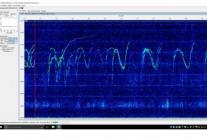Eavesdropping on the Gulf of Mexico
Thu, 09/12/2019 - 2:20pmA special Ocean Sound issue of ECO Magazine (Environment Costal & Offshore Magazine) features an article by Physics Professor Natalia Sidorovskaia. In the article Eavesdropping on the Gulf of Mexico Dr. Sidorovskaia discusses her work on the effect of human-induced noise pollution and the Deepwater Horizon accident on the marine mammal population in the Gulf of Mexico.
A brief extract is provided below to whet your appetite.
Over 70 percent of our planet is covered by oceans and yet less than five percent of it has been explored. Visible sunlight, which is about 40 percent of total solar energy received by our blue planet, doesn’t penetrate below 200 meters deep in the ocean. As we descend beyond these depths, it is dark and cold, but it is certainly not quiet.
Sounds can travel for many hundreds of kilometers in water. Deep-diving sea creatures have learned to rely on sound to explore the deep, uninviting abyss. Scientists can learn a wealth of information about ocean health and its inhabitants just by eavesdropping. The cacophony of ocean sounds is becoming louder, and our charismatic marine friends and distantly related mammals (dolphins and whales) have been facing multiple challenges as humans expand natural resource exploration and extraction, and global warming has become an everyday reality.
...
Gulf of Mexico: A Noisy Place Marine mammals share their space with humans who use acoustics to find natural resources, navigate ships, monitor subsurface infrastructure, and create additional noise pollution through heavy shipping and construction.
The Littoral Acoustic Demonstration Center – Gulf Ecological Monitoring and Modeling (LADC-GEMM) consortium has been collecting passive acoustic data in the Gulf of Mexico since the early 2000s. Its goal is to understand how industrial activities impact the marine mammal population in the Gulf of Mexico (GoM) which is home to 28 species of marine mammals, including two endangered species: sperm whales and Bryde’s whales. Please read the entire article and get the details.

